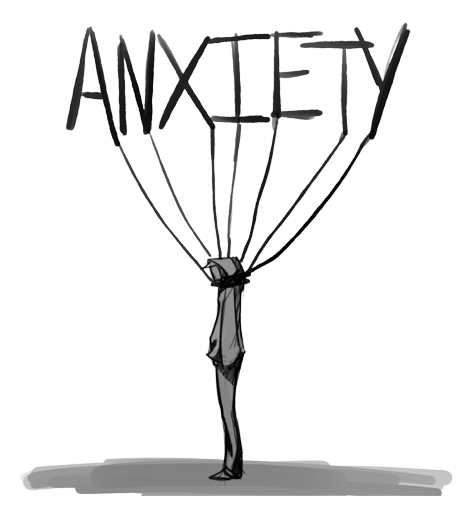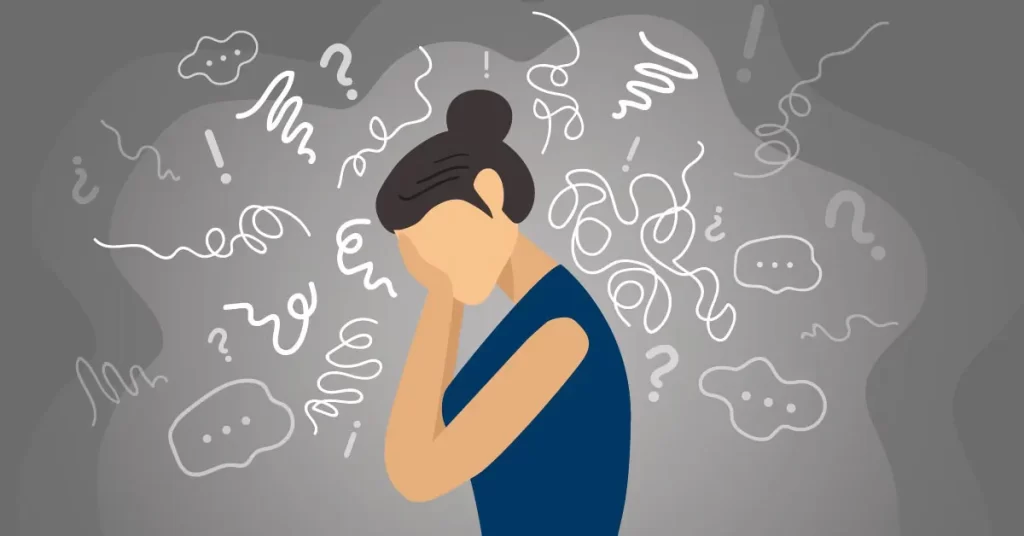A N X I E T Y
Updated on April 21st , 2022
Author: Tia Syal

Almost everyone has experienced that sudden feeling of fear before entering the classroom on the first day of school or going on stage to speak in front of a crowd. This sudden feeling of fear or apprehension is what we call anxiety. Such anxiety can be normal but when it becomes long-lasting, happening almost for everything everywhere, it becomes a medical condition.
WHAT IS ANXIETY?
The American Psychological Association (APA) describes anxiety as “an emotion characterized by feelings of tension, worried thoughts and physical changes like increased blood pressure.”
Anxiety refers to feelings of fear, apprehension, dreadfulness, and sudden pressure.
WHAT ARE ANXIETY DISORDERS?
Anxiety disorders are conditions in which a person experiences anxiety that does not go away and may hinder daily activities like job performance, schoolwork, etc. It’s normal to feel anxious about moving to a new location, starting a new job, or taking an examination. This type of anxiety is icky, but it may uplift you to work harder and do a more satisfactory job.
Anxiety disorders can be of various types:
- Generalized anxiety disorder (GAD): People with GAD worry about issues such as health, money, work, and family. But their worries are excessive, and they have them every day for a minimum of 6 months
- Panic disorders: People having panic disorders suffer from panic attacks. These are sudden, recurrent episodes of intense fear when there is no danger. Attacks come quickly and last for a few minutes or more.
- Phobias: People with phobias have a major fear of something that poses little or no danger. Such fears may be about spiders, height, going to crowded places etc.
CAUSES OF ANXIETY DISORDER
There is debatable research on the cause of anxiety disorders but some of the known causes are as follows:
- Brain chemistry. Some research indicates that anxiety disorders may be linked to flawed brains circuits that regulate anxiety and emotions.
- Genetics. Anxiety disorders may be present due to some genetic factors.
- Drug withdrawal or misuse. Usage of alcohol and substances often triggers the conditions of anxiety.
- Environmental anxiety. This directs to stressful events you have witnessed or lived through. Life events often connected to anxiety disorders comprise childhood abuse and negligence, the demise of a loved one, or being inundated or seeing brutality.
- Medical conditions. Heart, lung, and thyroid conditions can induce traits like anxiety disorders or worsen the existing disorder. It’s crucial to get a full-body exam to rule out other medical conditions when speaking to your doctor about anxiety.
SYMPTOMS
The main symptom of anxiety disorder is excessive fear and failure to deal with it.
Some common symptoms are as follows:
- panic attacks, excessive fear, nightmares
- numbness, cold, tingling of feet and hands, sweat
- nausea
- dry mouth
- sleep problems
- shortness of breath, faster breathing rates (hyperventilation)
- tense muscles
- dizziness
- shaken concentration
- unable to stop thinking about a problem
- heart palpitations
- extremely sidestepping feared places or objects
TREATMENT
Once the disorder has been diagnosed, treatment becomes a necessity. Occasionally medical treatment is not needed as symptoms can be controlled by a change in lifestyle. Treatment of anxiety disorder is of two types:
- Medication
- Psychotherapy
1) Medication
Various medicines are used for the treatment of anxiety disorder. The drug is prescribed by a medical supervisor. The commonly used drugs are antidepressants, antipsychotics, benzodiazepines, beta-blockers, etc.
2) Psychotherapy
It is commonly known as talk therapy. This is a type of therapy in which people are taught how emotions affect behaviors. A qualified mental health professional attends and speaks to you about your ideas and emotions and presents ways to comprehend and handle them and your anxiety disorder.
- Cognitive-Behavioural Therapy (CBT) is a type of psychotherapy that is often used to treat anxiety disorders. CBT teaches you different ways of thinking and behaving. It can help you change how you react to the things that cause you to feel fear and anxiety. It may include exposure therapy. This focuses on having you confront your fears so that you will be able to do the things that you had been avoiding.
RISK FACTORS
The factors that make you more prone to having anxiety disorder are known as risk factors for anxiety disorder. The risk factors can be controlled but not all of them. Some of the identified risk factors are as follows:
- Childhood shyness: Shyness and fear of meeting new people during childhood can lead to the development of social anxiety disorder in future life stages.
- History of mental health issues: The presence of other mental health disorders like stress, depression, etc. increases the chances of having an anxiety disorder.
- Negative life events and trauma: Stressful life situations from the past. For e.g., the loss of a loved one or trauma from the past can lead to post-traumatic stress disorder (PTSD) and anxiety disorder.
- Substance addiction: Dependency on drugs and alcohol can lead to anxiety disorder but in some cases, they are used to ease anxiety situations.
- Low self-esteem: Negative thoughts about oneself can make way for anxiety disorders.
- Childhood abuse: Any kind of social, mental, or physical abuse during childhood acts as a stimulus for anxiety disorder in later stages of life.
- Other health conditions: Persistent concern about other health conditions and illnesses can also lead to the development of anxiety disorder.
CONCLUSION
Anxiety is a natural feeling or emotion one can experience but one should be able to differentiate between anxiety and its disorder. People should be aware of such emotions and once diagnosed, should seek immediate help from a medical professional. Anxiety is treatable!
Reviewer: Medha Tikoo
Editor: Dr. Jitendra Kumar Sinha
Related Articles

Revolutionizing Anxiety Treatment: miRNA Takes Center Stage

Title

Title